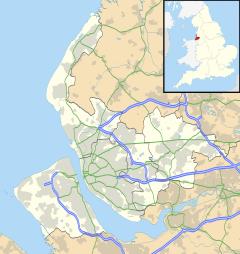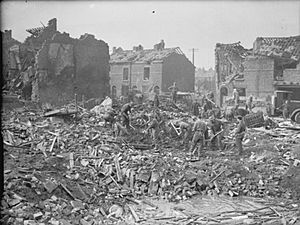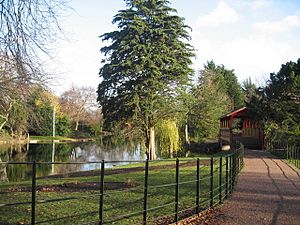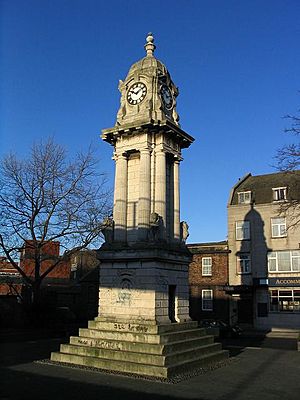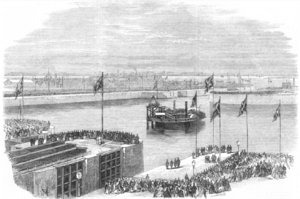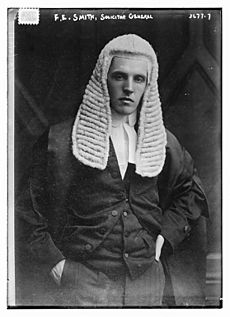Birkenhead facts for kids
Quick facts for kids Birkenhead |
|
|---|---|
| Town | |
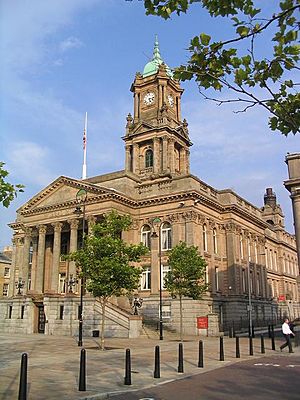 The former Birkenhead Town Hall and Wirral Museum, now council offices, committee rooms, and Register Office, in Hamilton Square |
|
| Area | 25.18 km2 (9.72 sq mi) |
| Population | 88,818 (2011 Census) |
| • Density | 3,527/km2 (9,130/sq mi) |
| Demonym | Birkonian |
| OS grid reference | SJ324890 |
| • London | 178 mi (286 km) SE |
| Metropolitan borough | |
| Metropolitan county | |
| Region | |
| Country | England |
| Sovereign state | United Kingdom |
| Post town | BIRKENHEAD |
| Postcode district | CH41, CH42 |
| Dialling code | 0151 |
| ISO 3166 code | GB-WRL |
| Police | Merseyside |
| Fire | Merseyside |
| Ambulance | North West |
| EU Parliament | North West England |
| UK Parliament |
|
Birkenhead is a town in the Metropolitan Borough of Wirral, Merseyside, England; historically, until 1974, in Cheshire. It is on the Wirral Peninsula, along the south bank of the River Mersey, opposite the city of Liverpool. At the 2011 census, it had a population of 88,818.
Birkenhead Priory and the Mersey Ferry were established in the 12th century. In the 19th century, Birkenhead expanded greatly as a consequence of the Industrial Revolution. Birkenhead Park and Hamilton Square were laid out as well as the first street tramway in Britain. The Mersey Railway connected Birkenhead and Liverpool, with the world's first tunnel beneath a tidal estuary, and the shipbuilding firm Cammell Laird and a seaport were established.
In the second half of the 20th century, the town suffered a significant period of decline, with containerisation causing a reduction in port activity. The Wirral Waters development is planned to regenerate much of the dockland.
Contents
History
Toponymy
The name Birkenhead probably means "headland overgrown with birch", from the Old English bircen meaning birch tree, of which many once grew on the headland which jutted into the river at Woodside. The name is not derived from the Birket, a stream which enters the Mersey between Birkenhead and Seacombe. The Birket is a later name which was introduced by Ordnance Survey.
Early history

The earliest records state that the Mersey ferry began operating from Birkenhead in 1150, when Benedictine monks under the leadership of Hamon de Mascy built a priory there. The priory was visited in 1275 and 1277 by Edward I. In a royal charter of 13 April 1330, Edward III granted the priory further rights.
19th century
Distanced from the Industrial Revolution in Liverpool by the physical barrier of the River Mersey, Birkenhead retained its agricultural status until the advent of steam ferry services. In 1817 a steam ferry service started from Liverpool to Tranmere and in 1822 the paddle steamer, Royal Mail, began operation between Liverpool and Woodside.
Shipbuilding started in 1829. An iron works was initially established by William Laird in 1824 and was joined by his son John Laird in 1828. The business eventually became Cammell Laird. Notable naval vessels built at Birkenhead include HMS Achilles, HMS Affray, CSS Alabama, HMS Ark Royal, HMS Birkenhead, HMS Caroline, Huáscar, the pioneer submarine Resurgam, HMS Thetis (which sank on trials in Liverpool Bay during sea trials, and was refloated and commissioned as HMS Thunderbolt, only to be lost to enemy action with the loss of the entire crew), HMS Conqueror and HMS Prince of Wales. Merchant vessels were also built such as RMS Mauretania and RMS Windsor Castle.
The Mersey Railway tunnel opened in 1886, providing direct railway access to Liverpool.
20th century
In September 1932 thousands of unemployed people protested in a series of demonstrations organised by the local branch of the National Unemployed Workers Movement. After three days of rioting, police were brought in from elsewhere to help quell the rioters.
In addition to the ferries and the railway, the Queensway road tunnel opened in 1934 and gave rapid access to Liverpool. This opened up the Wirral Peninsula for development, and prompted further growth of Birkenhead as an industrial centre. Bolstered by migration from rural Cheshire, southern Ireland and Wales, the town's population had grown from 110 in 1801 to 110,912 one hundred years later and stood at 142,501 by 1951.
Geography
The Birkenhead Urban Area, as defined by the Office for National Statistics, includes Birkenhead, Wallasey, Bebington, Ellesmere Port (which is outside the Metropolitan Borough of Wirral) and the contiguous built-up areas which link those towns. In the 2011 Census, the area so defined had a total population of 325,264, making it the 19th largest conurbation in England and Wales.
 |
Bidston Poulton |
Seacombe Poulton |
Liverpool (across River Mersey) |
 |
| Bidston Claughton |
Liverpool (across River Mersey) |
|||
| Oxton | Oxton Tranmere |
Helsby (across River Mersey) |
Demography
In 2011, Birkenhead had a population of 88,818. The wider Urban Subdivision had a population of over 142,000. However, this latter figure includes areas such as Greasby and Frankby, which are separate from Birkenhead.
These are the 2011 ethnic groups for the town:
- 93.5% White British
- 2.3% Other White
- 1.2% Mixed Race
- 2.6% Asian
- 0.2% Black
- 0.2% Other
Landmarks
Birkenhead Park is acknowledged to be the first publicly funded park in Britain. The park was the forerunner of the Parks Movement and its influence was far reaching both in Britain and abroad – most notably on Frederick Law Olmsted's design for Central Park. Designed by Joseph Paxton (later Sir Joseph Paxton) in 1843 and officially opened in 1847, with great festivity. The park's Grand Entrance, modelled on the Temple of Illysus in Athens, and its 'Roman Boathouse' are notable features. There are sandstone lodges at the three entrances, each with a different style of architecture, Gothic, Norman and Italianate. There are also two lakes and an ornate 'Swiss Bridge'.
William Laird, a Scot, and his son John, were influential in the design of the town. Parts were laid out in a grid-iron pattern like Edinburgh New Town with similar architecture. The chief architect was James Gillespie Graham from Edinburgh. This grid pattern was centred around Hamilton Square which was started in 1826 and, apart from Trafalgar Square in London, contains the most Grade I listed buildings in one place in England. including Birkenhead Town Hall. A short distance from Hamilton Square are two other notable landmarks: the Queensway Tunnel Main Entrance and the Woodside Ferry Terminal. The film Chariots of Fire had scenes shot at Woodside. These scenes were as a representation of Dover in the 1920s.
Other notable landmarks include Bidston Windmill on a ridge behind the town, Flaybrick Watertower and Birkenhead Priory & St. Mary's Tower.
Transport
Trams
Birkenhead had the first street tramway in Britain. Opened on 29 August 1860 the first line ran from Woodside (adjoining the terminal of the Mersey Ferry) to Birkenhead Park. This early system was horse-drawn and was the brainchild of flamboyant American, George Francis Train. A preserved tram was on display in the Woodside ferry terminal booking hall.
The system was later electrified and operated from 1901 as Birkenhead Corporation Tramways closing in 1937. Two replica trams, imported from Hong Kong, have been brought into service as part of a heritage tramway between Woodside and Wirral Transport Museum, and Birkenhead Corporation Tramways Car No.20 is preserved on this line.
Buses
Horse-drawn buses began operating in Birkenhead in 1848, to be replaced with motor vehicles after the First World War.
Present-day services are run by operators including Arriva and Stagecoach and coordinated by Merseytravel. Birkenhead bus station opened in 1996.
National Express provides long-distance coach services to other UK cities, with direct routes including London, Glasgow, Bangor and Newcastle.
Birkenhead Bus Station
Birkenhead Bus Station serves the town of Birkenhead. It is adjacent to The Grange Shopping Centre and Birkenhead Market.
It has a total of eleven stands and incorporates a travel centre. The main bus operators at the station include Arriva North West and Stagecoach Merseyside & South Lancashire
Bus services using the bus station operate around the town of Birkenhead, throughout the Wirral, and to the nearby city of Liverpool via the Queensway Tunnel. The station also has frequent services to as far away as Chester.
Railways
Railways reached Birkenhead in 1840, when the Chester and Birkenhead Railway began services. Birkenhead Grange Lane railway station opened at the same time, becoming the town's first terminus. Birkenhead Dock railway station opened in 1866, as the eastern terminus of the Hoylake Railway. With the opening of the Woodside and Birkenhead Dock Street Tramway in 1873, this station probably became the world's first tram to train interchange. In 1886 Birkenhead and Liverpool were linked by an underground railway system, which today is part of the Merseyrail network.
The major underground station in Birkenhead is Hamilton Square, the nearest station to the ferry terminal. Hamilton Square station is linked to the "Liverpool Loop" of the Wirral Line, which includes James Street, Moorfields, Liverpool Lime Street and Liverpool Central stations, all of which are underground. Other stations located in Birkenhead include Birkenhead Central which is open but below ground level, Green Lane which is below ground level, Rock Ferry, Conway Park which is below ground level, Birkenhead Park, Birkenhead North and Bidston.
The Wirral Line from Birkenhead travels south to Chester and Ellesmere Port, north to New Brighton and westwards, across the Wirral Peninsula, to West Kirby. The Borderlands Line leaves Bidston station, in the north of Birkenhead and travels through the rural centre of Wirral, ultimately leaving England near Shotton and terminating in Wrexham, Wales.
From 1878, until its closure in 1967, Birkenhead Woodside railway station was the town's mainline railway terminus. Originally located close to Woodside Ferry Terminal, the site had been redeveloped as part of Cammell Lairds ship builders. Latterly the adjacent dry dock at Cammell Lairds was filled in and the whole area redeveloped to provide flats, a bus depot and offices for HM Land Registry and Child Support Agency (CSA).
The town has one operational railway depot, Birkenhead North TMD; one disused, Birkenhead Central TMD; and two demolished, Birkenhead Mollington Street TMD and a further depot adjacent to Birkenhead Park station. The remains of the Birkenhead Dock Branch are still extant in a cutting through the centre of the town, which was used primarily for freight services. Much of the peripheral railway infrastructure, around the docks, has been removed since the 1980s.
Roads
Junctions 1 and 3 of the M53 motorway allow access to the national motorway network. The A41 trunk road connects Woodside with Marble Arch in London. Two road tunnels, the Queensway road tunnel from Birkenhead, and the Kingsway road tunnel from Wallasey, run underneath the River Mersey and connect the town to Liverpool.
Maritime
Birkenhead's dock system is part of the Port of Liverpool, operated by the Mersey Docks and Harbour Company under the ownership of The Peel Group. The Twelve Quays ferry terminal allows a direct freight and passenger vehicle service to Dublin, Ireland and Belfast, Northern Ireland. Daily Belfast services are run by Stena Line, using their RoPax ferries MS Stena Edda and MS Stena Embla from 2020–21, which replaced MS Stena Lagan and MS Stena Mersey. The Mersey Ferry at Woodside operates a passenger service to Liverpool and chartered cruising.
During winter months, the Isle of Man Steam Packet Company operates a service from Birkenhead to Douglas using MS Ben-my-Chree. Due to weather conditions, this service temporarily replaces the route that normally operates from the Liverpool landing stage using fast craft.
Aviation
The nearest airport is Liverpool John Lennon Airport (formerly known as Speke Airport) located about 8 miles (13 km) from Birkenhead. Manchester Airport is approximately 40 mi (64 km) from Birkenhead. Other nearby aviation facilities include Hawarden Airport and RAF Woodvale. Former airfields in the area include RAF Hooton Park and Bidston Aerodrome.
Religion
Religion in Birkenhead dates back to 1150 when Hamon de Masci founded Birkenhead Priory for the Benedictine order.
The current Anglican churches are St. James' Church, Christ Church, and the Church of Christ the King which are all within the Diocese of Chester. Keith Sinclair is the suffragan Bishop of Birkenhead.
Roman Catholic churches include the Church of Our Lady of the Immaculate Conception and St. Werburgh's Church which are within the Diocese of Shrewsbury.
The other religious buildings include the Wirral Christian Centre of the Elim Pentecostal Church and the Islamic Shah Jalal Mosque. The Jewish Birkenhead Synagogue existed from 1890 and closed prior to 2006.
Flaybrick Memorial Gardens contains the town's former main cemetery, which is situated near to St. James' Church. Flaybrick Hill Cemetery has been superseded by Landican Cemetery.
Arts and leisure
Arts
The Laird School of Art was the first public school of art outside London and was given to the town by John Laird. It opened on 27 September 1871. The Williamson Art Gallery was opened in 1928 and houses a fine collection of paintings, porcelain and pottery.
In 1856, Birkenhead Library was opened as the country's first public library in an unincorporated borough. The library was situated in Hamilton Street until 1909, when it moved to a new building in Market Street South, near Birkenhead Market. In the 1930s, this building (along with much of the surrounding area) was demolished to make way for the entrance to the Queensway Tunnel. The present library, Birkenhead Central Library, is situated on Borough Road and was opened by King George V in 1934.
Despite being in England, Birkenhead (known as Penbedw, in Welsh) hosted Wales' National Eisteddfod in 1917 as well as an unofficial National Eisteddfod event in 1879. As in Liverpool, migrants from Wales, especially North Wales, contributed greatly to the growth of the town and its cultural development in the 19th century. The first local Birkenhead Eisteddfod, a precursor of the national events, took place in 1864. The 1917 National Eisteddfod was notable for the award of the chair to the poet Ellis Humphrey Evans, known as Hedd Wyn. The winner was announced, and the crowd waited for the winner to accept congratulations before the chairing ceremony, but no winner appeared. It was then announced that Hedd Wyn had been killed the previous month on the battlefield in Belgium, and the bardic chair was draped in black. These events were portrayed in the Academy Award nominated film Hedd Wyn, and were apparently intended as a protest against the war policies of Prime Minister David Lloyd George, who was present. There is a commemorative stone for the event in Birkenhead Park. The first meeting of the international Celtic Congress also took place at the Birkenhead Eisteddfod.
The Argyle Theatre was a major theatre and music hall which opened on 28 December 1868 and became notable for the calibre of artistes who appeared there. Later in its life, it was also used as a cinema. The theatre was destroyed by bombing in 1940.
The Theatre Royal, opened on 31 October 1864, was in Argyle Street and had a capacity of 1,850. This theatre was closed in 1919 and demolished in the 1930s. Another theatre, the Hippodrome, which was converted into a cinema in the 1930s, stood on the site of what became the Co-operative department store in Grange Road.
The Little Theatre was established in 1958 from a converted former Presbyterian church, whilst more recently, the Pacific Road Arts Centre in Woodside opened in 1999.
Media
Birkenhead is served by the Liverpool Echo local daily newspaper. The free local weekly newspapers are the Wirral Globe and the Birkenhead News (part of the Wirral News group).
The local radio station Heart Wirral is based in offices at the Pacific Road Arts Centre. In addition, there are five other local radio stations that transmit to Birkenhead: BBC Radio Merseyside, Radio City 96.7, Magic 1548, Juice 107.6 and CityTalk.
Birkenhead is situated within the television regions of BBC North West and ITV's Granada Television. The local television station Bay TV Liverpool also broadcasts to the area.
Leisure
As well as Birkenhead Park, other recreational open spaces in Birkenhead include Mersey Park and Victoria Park. Arrowe Park is a large area of parkland at the western edge of the town. In 1929, the 3rd World Scout Jamboree was held there.
The first two Boy Scout groups in the world were founded as the 1st and 2nd Birkenhead groups at the YMCA on the same night in 1908.
Sport
The first known football club on the Wirral was Birkenhead F.C. which was founded in 1879 by Robert E. Lythgoe, a former Druids F.C. player. Other clubs included Belmont Football Club, founded in 1884. They adopted the name Tranmere Rovers F.C. the following year, and are a professional team who play at Prenton Park near the Tranmere area of the town. They were a founder member of Division Three North in 1921, and were a member of The Football League until 2015, when they were relegated to the Conference, the fifth tier of English football. (An unrelated, disbanded side had played under the name "Tranmere Rovers Cricket Club (Association football section)" in 1881–82.) Cammell Laird 1907 F.C. is the town's semi-professional football club who play at Kirklands in Rock Ferry. They are in Northern Premier League Division One North.
The Birkenhead Park Football Club was founded in 1871, the same year as the Rugby Football Union. The club originally played in the Lower Park but moved to their current home in the Upper Park in 1885. Birkenhead Park also has its own cricket club.
Located in the town are the Birkenhead North End & Victoria Cycling Clubs. Olympic riders from the clubs include Chris Boardman, Mark Bell, Steve Cummings and Rachel Heal.
International relations
Twin towns
Birkenhead is twinned, as a part of Wirral, with:
 Gennevilliers, France
Gennevilliers, France Latina, Lazio, Italy
Latina, Lazio, Italy Lorient, France
Lorient, France
Twin towns – Sister cities
Birkenhead also has a Sister City Agreement with:
Future
The major redevelopment project under consideration is Peel Holdings' "Wirral Waters". This would allow for £4.5 billion of investment in the regeneration of the dockland area. This equates with an investment of over £14,000 for each of the 320,000 residents of the Wirral. At the East Float and Vittoria Dock, the development would include several 50-storey skyscrapers, 5,000,000 square feet (465,000 m2) of new office space and 11,000,000 square feet (1,000,000 m2) for new residential flats. A retail and leisure quarter at the former Bidston Dock site would encompass another 571,000 square feet (53,000 m2) of space. The whole project would create more than 27,000 permanent new jobs, aside from the employment required for construction and other peripheral employment. The development would be expected to take up to thirty years.
Economy
Shipbuilding
Shipbuilding and ship repair has featured prominently in the local economy since the 19th century. Cammell Laird entered receivership in 2001. The shipyard was sold and became 'Northwestern Shiprepairers & Shipbuilders' (NS&S), which grew into a successful business specialising in ship repair and conversion, including maintenance contracts for the Royal Fleet Auxiliary. In September 2007 NS&S acquired the rights to use the Cammell Laird name. The company was renamed 'Cammell Laird Shiprepairers & Shipbuilders' on 17 November 2008, seeing the famous name return to Birkenhead after a seven-year hiatus. In 2010, Cammell Laird secured a £50 million contract to construct the flight deck for HMS Queen Elizabeth, the first of two Queen Elizabeth-class aircraft carriers. In 2015, Cammell Laird was selected as the preferred bidder to construct RRS Sir David Attenborough, a Royal Research Ship.
Commerce
Birkenhead Market was first established on what is now the site of Birkenhead Town Hall, between Chester Street and Hamilton Street, on 10 July 1835. An increase in the town's population by 1841 led to the opening on 11 July 1845 of a much expanded market on a larger site nearby. This market hall was built by Fox, Henderson & Co, who later built The Crystal Palace. Michael Marks, of Marks & Spencer, opened one of his first seven 'Penny Bazaar' stalls here during the 1880s. On 31 January 2018, Marks & Spencer announced the closure of their store, in the town centre of Birkenhead, happening in April.
During the 1970s, the commercial centre of the town was redeveloped around the principal shopping area of Grange Road. Following two fires at the expanded Birkenhead Market in 1969 and 1974, it was moved to new premises adjoining the Grange Shopping Precinct development in 1977. Commercial expansion continued in the early 1990s when the Pyramids Shopping Centre was opened. The previous market site has been redeveloped with the construction of two office buildings, primarily to house Land Registry and Department for Work and Pensions offices.
Economic statistics
In February 2010, the town had an overall unemployment rate of 8.2% (males 12.4%, female 4.1%) as against a national average of 4.4%.
Education
Schools
Birkenhead has a number of maintained schools, including Birkenhead Park School (formed after the merger of Rock Ferry High School and Park High School) and the only all-boys Catholic grammar school in the area St. Anselm's College.
Birkenhead also has two independently run schools. The oldest is Birkenhead School. It was exclusively a boys' school from its founding in 1860 until 2000, when its sixth form became co-educational. It became fully co-educational for pupils aged 3–18 in 2008. "Old Birkonians" (as former pupils are known) include the lawyer F.E. Smith (Lord Birkenhead); Andreas Whittam Smith (chairman of the British Board of Film Classification (BBFC) and founder of The Independent newspaper); Andrew Irvine, and Philip Toosey, hero at the Bridge on the River Kwai; and Tony Hall, Director-General of the BBC.
Birkenhead High School Academy, formerly Birkenhead Girls High School, is an all-ability state funded girls' Academy. It was founded in 1885 and caters for girls aged 3–19. Its sponsor was the Girls' Day School Trust, but is now publicly funded. Its alumnae include the actress Patricia Routledge. Birkenhead Girls High School decided to become a state-funded Academy school in 2009, increasing the availability of its education. Like the change to co-education at Birkenhead School, this decision was largely driven by falling pupil numbers; however to this date, it remains a single sex school.
Birkenhead Institute Grammar School existed from 1889 in Whetstone Lane, before being moved to Claughton in the 1970s. The school closed in 1994. The school's alumni include Wilfred Owen.
Colleges
Previously situated at Borough Road, Birkenhead's college has campuses at Europa Boulevard and Twelve Quays. The college was originally Birkenhead Technical College, and has been known as Wirral Metropolitan College since the 1980s. The college had a theatre on Borough Road named after one of its most famous former students, Glenda Jackson, the Oscar-winning actress and Member of Parliament, herself a Birkonian, born in 1936. The Borough Road campus and the Glenda Jackson Theatre were demolished in late 2005, to make way for flats, although Wirral Metropolitan College flourishes on other sites across Wirral. The theatre secretly housed an emergency command centre for the region in its basement, accessible via the college. Politicians and officials would have retreated to this secure bunker in the event of nuclear war to co-ordinate the recovery effort. By the 1990s, after the end of the Cold War, the bunker had been decommissioned and the surrounding complex of rooms was used by the college as a rehearsal space and recording studio.
Other colleges include the Birkenhead Sixth Form College, located in the Claughton area of Birkenhead, formerly the site of Corpus Christi Catholic High School.
Notable people
Actors and performers
In the arts, Birkenhead has produced several actors and performers including Lionel Gamlin, Roger Abbott, Glenda Jackson, Anew McMaster, Lewis Collins, Megs Jenkins, Taron Egerton, Patricia Routledge, Paul O'Grady (also known as Lily Savage), soprano Valerie Masterson and baritone George Baker. The dancer and actor Lindsay Kemp was born in the town but as a child moved to South Shields. Opera director Graham Vick was born in Birkenhead.
Artists
Some notable artists were born in the town, such as Philip Wilson Steer, Robert Talbot Kelly, Tom Palin, Bessie Bamber, Annie R. Merrylees Arnold, the workers at the Della Robbia Pottery and two cartoonists: Norman Thelwell and Bill Tidy.
Authors and journalists
It has also produced poets and authors such as A.S.J. Tessimond, Adrian Henri and Michael Z. Williamson. The World War I poet Wilfred Owen, though born in Oswestry, lived in Birkenhead from the age of 4 and was educated at the Birkenhead Institute High School (now demolished). Andreas Whittam Smith, founder editor of The Independent, grew up in Birkenhead, where his father was an Anglican clergyman.
Musicians
There are several musicians linked to the area. Freddie Marks from Rod, Jane and Freddy was born in Birkenhead, as was John Gorman of The Scaffold. Indie band Half Man Half Biscuit hail from Birkenhead, as did boogie-rock band Engine, Paul Heaton, lead singer of the Housemartins and the Beautiful South, singer/songwriter Charlie Landsborough and Desmond Briscoe co-founder and original manager of the pioneering BBC Radiophonic Workshop. Elvis Costello moved to Birkenhead in 1971 with his mother, who was from Liverpool, although Elvis Costello's father was himself from Birkenhead. Tony Friel (bassist from the Fall and the Passage), synthpop musician David Hughes (of Dalek I Love You, Orchestral Manoeuvres in the Dark and Godot) and Malcolm Holmes (drummer with pop group Orchestral Manoeuvres in the Dark) were born there. David Balfe (music manager, and member of Dalek I Love You, Big in Japan, the Teardrop Explodes) attended primary and secondary school there. Miles Kane, musician, singer and songwriter and member of The Last Shadow Puppets and The Rascals, was born in the town as well as the opera singer Hugh Beresford.
Politicians and public figures
F. E. Smith, 1st Earl of Birkenhead, a leading Conservative politician of the early 20th century, was born in the town, as were Liberal Democrat politician Malcolm Bruce, Labour politician Stephen Ladyman, the prominent occultist Alex Sanders, and Tony Hall, Baron Hall of Birkenhead, the Director-General of the BBC. Theodora Llewelyn Davies was a British barrister and penal reform campaigner. She was the first woman admitted to the Inner Temple in 1920. Frank Ernest Field, Baron Field of Birkenhead DL, is a British politician who was the Member of Parliament for Birkenhead from 1979 to 2019, serving as a Labour MP until August 2018 and thereafter as an Independent
Scientists and technologists
Aerodynamicists Gwen Alston and Melvill Jones were born in Birkenhead, as was Henry Herbert Collier, inventor and founder of the Matchless motorcycle marque.
Soldiers and explorers
Sandy Irvine, a participant of the 1924 British Mount Everest expedition, was born in Birkenhead. There has been speculation that George Mallory and he reached the summit. Similarly, Alan Rouse, a mountaineer who died in the 1986 K2 disaster, was educated in Birkenhead. Daniel Poole, a recipient of the Distinguished Conduct Medal during World War I was born in the town.
Sports people
Birkenhead has also produced notable sportsmen such as Matt Dawson, the rugby union player; 'Dixie' Dean (Everton F.C.), record-breaking footballer, who was born at 313 Laird Street; and several other footballers including Peter Davenport, Jason McAteer, David Thompson, Max Power, Jodie Taylor England Lionesses International. The football manager Nigel Adkins also hails from the town.
Other
Images for kids
See also
 In Spanish: Birkenhead para niños
In Spanish: Birkenhead para niños


